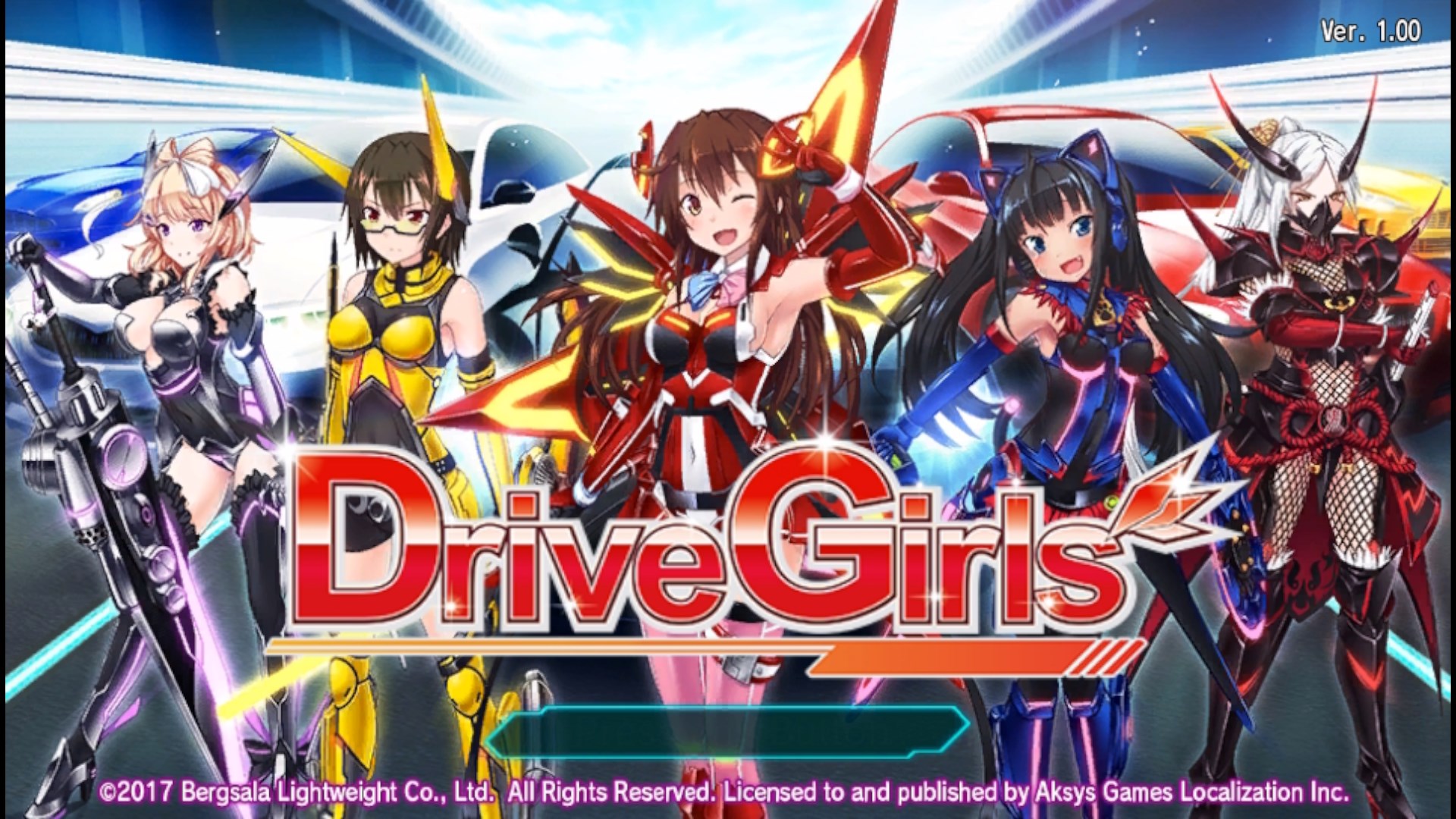The Sony Vita is an underrated gaming platform filled to the brim with interesting exclusives that would eventually see ports on the PC, PlayStation, and sometimes even the Nintendo Switch. Hyperdimension Neptunia and Senran Kagura are two major series that enjoyed success across multiple platforms. Some other games, like UPPERS, for example, were originally Vita exclusives but saw a PC port late in its cycle. Then there are special mentions like Drive Girls. Games that wouldn’t see such possibilities, remaining a Vita exclusive well into 2023.
Originally released in 2017, Drive Girls was developed by Tamsoft, best known for the Senran Kagura and Oneechanbara series. While I have spoken about both games quite often, Drive Girls falls under the Senran Kagura side of the scale, with its visual novel-esque cutscenes, character designs, and gameplay elements. Based on first impressions, it’s easy to denounce Drive Girls as Hyperdimension Neptunia with cars. Regardless of who developed the games, each developer had an interesting premise involving “girls who fight monsters in an action beat-em-up.”

As usual collaborators with D3 Publisher and Marvelous, it was rare to see a Tamsoft-developed game handled by a different publisher. Published by Aksys Games, they are best known for publishing the BlazBlue games in America. This deserves mentioning because of a piece of trivia based on the events post-main scenario. The protagonist, Lancier, is revealed to have a stuffed frog plush named George. Later, the Drive Girls Commander finds the pet and claims it as hers, naming it George The Second. This continued until a woman named Rachel Alucard animated a frog and named him George The Thirteenth.
Okay so that’s not what happened, but I found the BlazBlue reference cute and wanted to get that out of my system before I talked about Drive Girls. It’s no secret I am a fan of cars and racing. I am also a fan of cute anime-themed games that don’t require a lot of my brain to enjoy. The last time I played a game that combined racing and cute girls, I deemed Kandagawa Jet Girls as a sleeper ”B-movie” level anime game that is more than what’s shown on the surface. While I was instantly hooked on Kandagawa Jet Girls, this was after watching the anime to get myself adjusted.

Drive Girls is a completely original IP not based on an anime so my first impression was all I had to go by. I mentioned it was Hyperdimension Neptunia with cars, similar to how Neptune is named after the canceled Sega Neptune, and Vert is based on the Xbox. The Drive Girls are arguably cooler in the premise as they can transform into their respective cars, but the concept of a “cute girl based on a real object” remains the theme. Here are all five playable characters in order of which they unlock.
- Lancier - Mitsubishi Lancer Evolution Final
- Regalith - Toyota Crown S210
- Galaxa - Subaru Impreza (Fifth Generation Hatchback)
- Seven - Mazda RX-7 FD
- RR Thirty-Five - Nissan GT-R R35
Much like Hyperdimension Neptunia, Drive Girls does little to hide the inspiration based on real-life cars. Names like Seven, Lancier Revolution, the protagonist’s full name, and the Commander’s real name “RR Thirty-Five, all but reference their respective cars by code name or full name otherwise.
Despite knowing what the car is intended to look like, in the case of Galaxa’s “D-Form” being a Subaru Impreza, her name also references Subaru as the Japanese term for the Pleiades, a star cluster which also makes up the logo for the car company.

Perhaps the biggest head-scratcher would be Regalith, as my mind instinctively warped to the “Regalia” from Final Fantasy 15, but I’m convinced it’s based on the Toyota Crown. For Americans, unless they played Tokyo Xtreme Racer 3 and realized it was one of the best starter cars in the game, most wouldn’t know of the car by its Asian name. The best point of reference would be the Lexus GS models in the West although the Crown stopped sharing the same body chassis as the GS for quite some time.
Regardless, it looks close enough to a Crown and Regalith obviously references “crowns and royalty,” so therefore it is a Toyota Crown. Regardless of who the player selects, the gameplay is similar across all five characters. Seven is the speed character, Galaxa is ranged, Regalith is the tank, and Lancier is balanced. The Commander, RR Thirty-Five, isn’t unlocked until all 27 episodes have been completed. She’s somewhere a mix between all four characters with an emphasis on close range.

Each episode consists of at least one mission and clearing all missions in an episode moves on to the next one. Drive Girls’ plot across these episodes isn’t much to write home about. Lancier wants to work as an EMT and wounds up late for the exam due to several inconveniences. She ends up taking the test anyway that has her fight against this alien species that are known as Bugs. Despite “killing foreign enemies” not being a part of the job description for an EMT, Lancier passes with “flying colors.”
Then she meets the Commander and Regalith who tells Lancier that she did not get the role of an EMT but as a member of the Drive Girls, a task force designed to eradicate Bugs. When I got to this part, I had to double-check to make sure that these weren’t the same developers who did games for Earth Defense Force. In that series, you also have to eradicate alien bugs, but the game was published by D3 Publisher, a publisher Tamsoft had also worked with. Coincidence?

After Lancier reluctantly joins the group, they run into a native on the island, Galaxa, who wants to get rid of the Bugs for ruining her racing plans. She joins the group and after defeating the majority of the Bugs, the Commander gets kidnapped. She’s totally going to be A-OK so no worries. Someone from HQ, Seven, shows up with great worry however and joins the group in hopes of finding the Commander. With the core four established, it’s revealed that the Bugs can take on replicas of the Drive Girls, causing them to fight clones of themselves.
Upon freeing the Commander, they confront the bug queen, defeat her, and cut off the breeding source of the Bugs much like an Aliens film except none of the horror, or the thrill, or the enjoyment honestly. I played through all 24 episodes with the three bonus “post-credits” missions bumping it up to 27 in one sitting. I highly advise anyone interested in this game to not do the same as I felt myself get dizzy. It was a different level of mundane, so much so that I almost knew what was going to happen each and every time.

The target is a cutscene involving the Drive Girls, the navigator, endearingly named Naviko (Navi-girl), exclaims that Bugs are approaching, the Drive Girls say their catchphrase “AUTO GIRLS ROLL OUT!” or something, they squash the Bugs, next mission. In between missions, there’s always a fanservice scene out of nowhere, random comments, some resemblance of a plot, “BUGS DETECTED!” “AUTO GIRLS ROLL OUT!” Squash more Bugs, Mission Complete, a future party member shows up, you challenge them to a race, you unlock them, “BUGS ARE APPROACHING—”
The previous paragraph is where I will have to unveil the curtain and break the fourth wall. Reader, this was the state of my mind after the halfway point when I realized that everything I saw in the first five episodes was the entire game. There is nothing done to shake things up, the gameplay is the exact same no matter who the player chooses, and the enemies only get tougher and unfairer. I couldn’t tell you when the difficulty spike happens, but one minute it’s a “square button mashing” simulator and the next moment, the enemies mash back, harder.

Despite the name, the Drive Girls don’t usually “drive.” Pressing the R button will transform the girl into their car form, but the controls are interesting. Holding R accelerates while also ramming into enemies and holding L will initiate a “drift” that adjusts the car’s angle. Square attacks with a tailspin while the triangle is an attack that enters the girl’s fighting form. In “fight form,” it’s the standard Musou flair. Square is a light attack, Triangle is a heavy attack, and Circle is a dodge. Holding the circle charges your “gear meter” which puts the player in Over Drive mode. In this mode, they can do their ultimate attack by holding the L button, but they lose the Over Drive buff, which makes it far more useful to keep it active.
There are also artillery weapons that I hadn’t found a use for until the end-game content as using them requires the same resource needed to Over Drive. These firearms are incredibly useful in dealing large pockets of damage and once the player figures out the exploit, Drive Girls breaks itself down. If a game’s premise is about “cute girls transforming into a tuner’s dream car,” then I’d hope there’d be more “driving” content. Instead, “driving” is just another method of attacking and getting to places in a timely manner. There are less than a handful of “races” and all they consist of is running laps around the same exact course each time.

The driving controls, as also expected, are very flimsy, not behaving like real cars at all and more like a game where “a character can transform into a vehicle and ram themselves into opponents.” It still felt cool during certain levels, driving through a downtown city in a Nissan GT-R while also doing donuts on Bugs. Unfortunately, the majority of the levels are located in deserts and barren locations. Players who for some reason are expecting a grand story shouldn’t expect to find one in Drive Girls. Each cutscene is episodic with a paper-thin shounen-level plot that does what it needs to.
Despite this, the gameplay is fun despite the camera also working against me at times. There are also loads of hours of content. Far more than I expected from a game of this nature. After clearing the solo campaign, there’s a multiplayer mode with exclusive enemies, missions, and unlockables meant to explore. Completing the missions is possible as a solo person but the difficulty makes it meant for more than one. Regardless, I was pleasantly surprised to find more stuff to do even after the number of hours I sunk into Drive Girls.

There’s something awesome about controlling a person that can transform into a car and an entire world filled with others like them. Unfortunately, the game wasn’t successful enough to convince Aksys to continue with the idea, but this could have easily been their Hyperdimension Neptunia. Imagine the elderly being an older Nissan 240z or the stereotypical “yee-haw” American turning into a Camaro? It would have been awesome and it also wouldn’t be the first time “girls turning into cars” would be a pitched idea.
Despite its lack of success, games like Drive Girls remind players that every platform has its fair share of underrated gems that are lost on the platform’s exclusivity. With the push for multi-platform releases, this isn’t as much of a cause of concern as it was in the past. There are still many titles that deserve their shine in the spotlight with interesting premises and mechanics that would inspire future projects. Hopefully someone else can make the “girls turning into cars” dream a reality.

